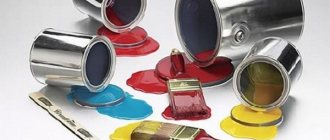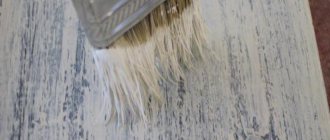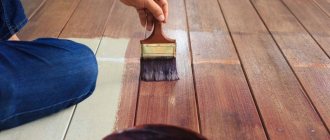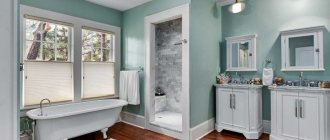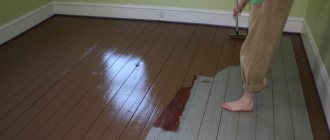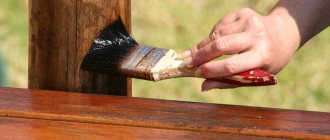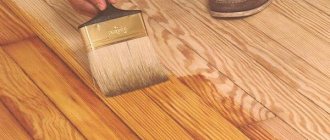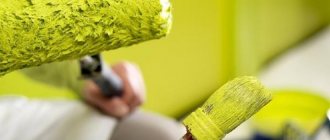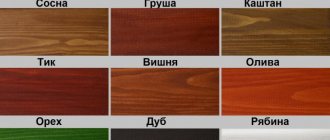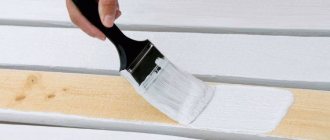Painting wooden surfaces is one of the most popular wood treatments. Using paint, you can create a unique interior design without spending a lot of money and effort. You can even paint a wooden surface yourself, which is what owners who are planning to renovate their home most often do. In order for the wood not only to look good after processing, but also to be in excellent condition for a long time, you need to know how to paint wood correctly and what kind of paint is needed for this.
What types of wood paints are there?
To treat indoor surfaces, you can use one of 4 types of paints: acrylic, alkyd, water-dispersion and polyurethane. Any of the paints must contain a pigment, a base that binds all the components and forms a surface film, various fillers for the shine of the surface and its strength, as well as additives with which the paint dries faster and makes the surface resistant to fire.
- Acrylic paint is distinguished by its low price, which at the same time does not greatly affect the quality of the composition. It is also quite practical, which is confirmed in conditions of sudden temperature changes and frequent exposure to sunlight. In addition, the paint prevents the wood from rotting and crumbling. Thanks to the dense consistency of the paint, which is evenly distributed over the surface, it creates a coating that is resistant to mechanical stress. Acrylic-based paints dry fairly quickly, which is also a significant advantage.
- Alkyd paint is equally successfully used for both interior and exterior work. It consists of alkyd varnish, solvent, coloring additives and fillers. For more than 4 years, alkyd paint has protected the surface from the effects of various negative factors. It can withstand both very low and very high temperatures. Alkyd enamel also has good water resistance and high resistance to mechanical damage. It takes a long time to dry – 2-3 days. It's inexpensive.
- Water-based paint with water as a thinner is an environmentally friendly option for the home. This paint is sold in the form of a paste with a liquid consistency, which must be diluted with a certain amount of water immediately before use. When drying, the water from the paint evaporates, as a result of which the paint hardens and becomes resistant to influencing factors. This paint dries quickly - it only takes a few hours, and it has no smell, which is a huge plus for rooms. It has good water resistance and resistance to mechanical stress. Can last as long as 15 years. Easy to use and relatively inexpensive.
- Polyurethane paint has a good consistency, which allows it to adhere well to a wooden surface and form a surface with high protective properties. This paint is highly resistant to various external factors. Non-toxic, non-flammable. It has a huge variety of colors and shades.
Which paint to choose
Knowing what paints exist for treating wooden surfaces makes it easier to choose. Based on the distinctive characteristics, you can determine which one is more suitable in your case. But if you have not yet figured out which paint is suitable in your case, then the following tips will help you.
- If you are faced with the task of adding color to interior doors, floors, and baseboards, then it is best to use water-dispersion paint.
- To hide unevenness, for example, when finishing a house made of timber, it is best to use acrylic paint.
- When treating walls, floors, doors and other wooden elements in a children's room, it is best to give preference to acrylic paints with the ability to easily wash them off, as well as with a note about the environmental friendliness of the composition.
- Polyurethane paint can be used to paint floors and stairs.
- For rooms with high humidity, it is worth using compounds with an antifungal effect, for example, acrylic paint.
- Alkyd paint has a strong odor, so it is rarely used for interior work. But it perfectly levels surfaces.
Review of the best brands
Popular odorless dyes include the following products:
- Tikkurila Empire. This is a universal paint with a thick consistency that is suitable for interior and exterior work. The composition does not leave smudges and dries within three hours.
- Teknos Biora Balance. Acrylate-based material does not cause an allergic reaction. The composition does not glare in the sun after drying.
- Alpina Butlank. This enamel contains substances that prevent the painted surface from turning yellow.
- Adler Lignovit Color. The mixture withstands precipitation and prevents the appearance of fungus and mold.
- Husky Siberian. The composition is characterized by low consumption and the presence of antiseptic substances. The material is suitable for finishing both external and internal surfaces.
When choosing wood dyes, you must take into account the previously given recommendations. These paints also have restrictions on use.
Technology for painting wooden surfaces indoors
Before applying the selected paint to a surface, it is necessary to prepare the surface. This work consists of several stages:
- Removing fungus and mold is the most important preparatory stage. If there is such damage to the wood, then it is necessary to treat the wood with special preparations.
- We remove irregularities - there will definitely be knots on a new wooden surface. They need to be removed. There may also be resin. It needs to be heated with a special hairdryer and removed. Places are sanded using sandpaper. It is also necessary to cover these places with shellac - the product will help prevent the release of resin.
- Removing old coating, if any. Cracked paint can be removed with a spatula; if you have a technical hair dryer, it will come in handy here. With its help, the paint will become softer and easier to remove. Then we rub the remaining material with sandpaper.
- We remove defects. If there are holes in the wood, they must be filled with putty. Finding putty is not difficult - you just need to make sure that it is suitable for wooden surfaces. After puttying, smooth it out with sandpaper.
- Degreasing is a mandatory step, without which high-quality painting is impossible. In this case, you will need a nitro solvent or extraction gasoline. We treat all the wood with the liquid to eliminate the presence of greasy stains. Then use a brush to clean the entire surface.
After the preparatory stage, the surface needs to be primed. This is necessary so that the paint adheres better to the surface. Also, thanks to the primer, less paint is consumed. And the primer also helps prevent stains from bleeding through the paint. For priming, use drying oil or a colorless primer specifically for wood. After a day you can start painting.
To apply paint correctly you need to know a few things:
- Application is best done with a flat, wide brush. A spray gun is also great.
- You don’t need to put a lot of paint on the brush, just dip it into the solution by a third.
- For best application, brush along the grain of the wood, not across it.
- The brush should be moved smoothly and should not be pressed too hard against the surface.
Painting is carried out in two or three passes. First, apply the first thin layer, then wait until it dries, then apply the second thin layer. Then, if necessary, you can apply a third layer. It should be remembered that applying several thin layers will be more effective than one thick layer. A few more tips to ensure that the painting turns out to be of the highest quality and looks like it was done by professionals, even if you are doing it for the first time:
- To avoid visible brush marks, the last layer should be applied from top to bottom.
- To ensure a uniform paint color, the mixture must be thoroughly mixed before application.
- The color does not always correspond to what is stated on the package, so it is better to make a test stroke before painting.
- Degreasing with an alkali solution before painting will improve the adhesion of the paint to the surface, and therefore make the painting more durable.
- Painting should not be carried out at high room temperatures, because the paint will dry faster and you may get a worse result.
- To finish surfaces in a modern style, you can combine two colors when painting. Typically, in this case, a darker shade is applied as the first layer, and a lighter and brighter shade as the second. This produces an interesting effect.
- To create the effect of bleached oak, you need to use light paint, which is applied in a thin layer two to three times.
About possible mistakes in painting wood - in the video:
Thus, the paint from the Finnish company Tikkurila is rightfully considered the best paint for wood. Paints from Teknos and Alpina have also proven themselves well. But in order to paint wooden surfaces indoors with the highest quality possible, not only the paint is important, but also the skills of the craftsman. Therefore, before doing this work, it is better to familiarize yourself with the technology of properly painting wood.
FAQ
1. Is it necessary to prepare the surface and clean it for applying paint if the product is rusty and has some defects? How do anti-rust compounds work?
Anti-rust paints contain fatty acids that neutralize the process of rust spreading, and the protective layer preserves the product. But, since the surface of metal with traces of rust is porous, it is better to do a little preparation of the metal. To do this, run sandpaper over the surface or other abrasive material, wipe the product dry with a rag and degrease with acetone or alcohol.
2.How does paint density affect consumption? What other paint indicators should be taken into account when calculating consumption?
The higher the paint density, the more firmly and completely the initial surface of the metal will be covered. Covering capacity is indicated by the manufacturer for ideal conditions, so it is better to take a correction factor of 1.3 (multiplying the calculated amount of composition). In this case, we can accurately calculate the consumption. But even the best paint will not cover the initial surface in one layer, only if it is a new product without flaws.
3. It is necessary to paint a surface that heats up to significant temperatures (metal oven). What kind of high-temperature paint can be used, and how do they differ from ordinary enamels?
When choosing heat-resistant paint, we focus on the operating temperature at which the coating will not deteriorate and will retain its original characteristics. On average, the compositions can withstand 400-600°C, which is enough to paint a metal stove. Paint with silicone resins is suitable for your case.
4. How to remove old paint from metal surfaces?
There are three main ways to remove old paint from metal surfaces. Firstly, the mechanical method. The layer is removed with an abrasive, but the effect can only be obtained on relatively flat surfaces.
Good results are obtained when using cord brushes on a drill or flap emery wheels on an angle grinder. Carefully look at the markings on the brushes for maximum speed, use thick canvas gloves, goggles and a respirator or protective mask.
Secondly, the chemical method. We purchase a gel or liquid composition that is intended for these purposes and apply it to the surface with a brush. The composition is very active; you should work with plastic gloves and a protective apron. Glasses required. The product eats through rubber products in 2-3 minutes.
The compositions are a complex composition of chemically active substances. As a rule, manufacturers include in the solution: complexing agents, corrosion inhibitors, alkalis (or acids), surfactants.
And the third way is fire. Using a blowtorch (not a cutter), heat the surface until the paint burns. The main thing here is not to overheat the metal, otherwise it will deform. After the fire treatment, we clean off the remaining paint layer with an abrasive or a wire brush.
5. I heard that there are so-called “soils”. How do they differ from paintwork on metal? Are they a complete replacement for metal coating? In what cases should primer be used and is it necessary to “lay” a layer of full-fledged paint on top of the primer?
The primer is intended for the primary coating of metal and the formation of a protective layer before applying a decorative composition. “Soil” provides protection against corrosion, smoothes out defects, and creates a strong base for enamels. The primer blocks contaminants that cannot be removed from the surface.
The primer differs from paint and varnish coatings by the presence of special complexes in the composition that prevent rust from developing and protect the metal from moisture penetration. However, paints are now being produced that “work” no worse than primers (3 in 1).
As a rule, primer is produced in one color, often “brick” or another not very attractive matte color. You can use only a primer when painting if the aesthetic component of the appearance of the product is not important to you. To ensure shine and ensure an even coating on the ground, apply the selected paint in two layers.
What compositions are quick-drying?
The time until the surface dries completely depends on the composition of the material, as well as the temperature conditions in the room. The most common quick-drying paints are:
1) Nitro paints. The drying time of the first layer when sprayed from an aerosol can is no more than half an hour, the subsequent layer takes twice as long to dry. In the liquid version, nitro paints dry more slowly, taking several hours. Disadvantages - they have a sharp toxic evaporation and an unpleasant aroma.
2) Acrylic. The first layer dries in 4 hours. Advantages – does not have a strong aroma, safety and moisture resistance.
3) Water based. Drying time for the first layer is half an hour. Advantages: odorless and non-toxic.
4) Latex. Dries in 60 minutes. Advantages: odorless, safe and moisture resistant.
| Time for 1 layer | Toxicity | Smell | Moisture resistance | |
| Nitro paints | 30 minutes | + | + | — |
| Acrylic | 4 hours | — | — | + |
| Water based | 30 minutes | — | — | — |
| Latex | 60 minutes | — | — | + |
Characteristic features of alkyd varnishes
Alkyds are made from synthetic solvents and alkyd resins. Consumption per layer - from 70 to 75 g. per square meter. They are used primarily for varnishing furniture or coatings subject to increased wear.
The main advantages and disadvantages of alkyds will be listed below. This is one of the most commonly found groups of paints and varnishes on the market. There are a number of reasons for this.
Advantages of alkyds:
- Competitive cost. This is perhaps the main factor ensuring the popularity of this group of materials. The use of such varnishes is considered economical when processing large areas, which leads to the frequent use of alkyds in construction.
- Working with alkyds is not difficult, and the set of tools is limited to a roller or brush.
- Very resistant to moisture and durable.
- The composition is almost colorless.
- The compositions are considered universal. Such varnishes can be used not only indoors, but also outdoors (although this happens much less frequently).
- Aesthetic appearance of varnish film.
- Excellent light and thermal stability.
- Elasticity.
- Good adhesion characteristics.
Alkyd (glossy) varnish for interior work Disadvantages of alkyds:
- They dry for quite a long time, although faster than, for example, oil-based ones. Average drying time is 3 days. To speed up the drying process, product manufacturers add special hardeners to the composition, which reduce the time of the above process to a day. There are also alkyd-urethane varnishes, which are characterized by even faster drying - from 6 to 12 hours. But the main thing is that alkyd-urethane products are characterized by very high wear resistance.
- Toxicity.
- When treating the surface, as well as during drying, the varnish layer must be protected from moisture.
- To obtain acceptable quality, 2-3 layers are needed.
The incompatibility of alkyd and acrylic is due to the different composition of the materials. Alkyds are based on polyhydric alcohols and are produced by polycondensation with orthophthalic acid. There are two types of alkyd compounds: pentaphthalic and glyphthalic.
Without smell
Odorless paints and varnishes include those types that do not have toxic fumes and are therefore safe.
The following varieties are distinguished: 1) Water-based (water-dispersed). The base is water, so there is no strong aroma, and it dries quickly.
2) Acrylic. It is odorless, non-toxic and dries quickly.
3) Latex. It is an improved water-dispersion version. The latex base dries quickly, the treated surface has increased moisture and wear resistance.
Areas of application
Alkyd enamels not only prevent the negative effects of external factors on the treated surface, but also protect the product from corrosion. The range of applications for such mixtures is quite extensive. Today they are used for:
- Treatment of metal roofing, drainage communications, fencing, heating radiators and benches.
- Painting wooden structures: log walls, facade parts of frame structures, etc.
- Decoration of concrete slabs, asbestos-cement screed and brickwork.
To form a protective film on a concrete or wooden surface, it is recommended to purchase an alkyd composition with urethane fillers.
How to apply the coating correctly
First of all, it is necessary to carry out preliminary preparation of the walls - clean off the old coating and degrease.
Before painting, the surface is covered with primer. This will help avoid problems during application and subsequent operation. Apply the coating in a thin layer, then wait until it dries completely. A second application will help even out the color and achieve a better result.
Features of water-based wall paints: how much the compositions cost, their types
Water-based dyes have a liquid consistency. Due to this, the protective coating is reliable, because the composition is able to penetrate deep into the wood. The mixture is based on water, coloring pigments and binders. In addition, the composition contains fillers that ensure quick drying of the paint, moisture resistance of the coating, etc.
The composition and consistency of water-based wall paint can be adjusted for ease of application using water
To dilute the dye, an organic-based solvent is used. White Spirit is optimal for these purposes. The coating dries 2-6 hours after application. There are several types of emulsions on sale, so it is recommended to carefully study the information on the packaging.
Tools for work
For painting you will need:
1) Brushes for painting hard-to-reach areas.
2) Roller for painting large surfaces.
3) Spray bottle for painting large areas.
4) A roller with a bendable plate, which allows you to separate the area that should not get dirty. Used at the junctions of ceilings and walls.
Among the entire range of paints and varnishes, only three types fully meet the “odorless” and quick-drying characteristics. These are acrylic, latex and water-based paints. Also, such coatings are non-toxic and safe to use, and acrylic and latex coatings can be used in rooms with high humidity.
Tips for choosing
When choosing paint for apartment renovation, take into account the following criteria that the material must meet:
- adhesion – more than 0.5 MPa;
- quick-drying;
- environmentally friendly;
- easy to apply;
- hiding power above 95%;
- washable;
- antifungal (for wet rooms);
- good value for money;
- durable;
- elastic.
In addition, it is desirable that paintwork materials for interior work are free of harmful odor.
After finishing the painting work, a small amount of mixture may remain
Therefore, you need to pay attention so that the material is not picky about storage conditions and is used everywhere. In this case, it can be used for another purpose
